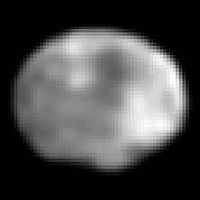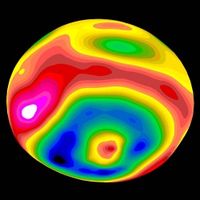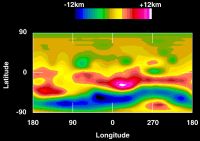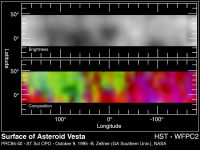4 Vesta
2007 Schools Wikipedia Selection. Related subjects: Space (Astronomy)
 |
|
| Discovery A | |
|---|---|
| Discoverer | Heinrich Wilhelm Olbers |
| Discovery date | March 29, 1807 |
| Alternate designations B |
none |
| Category | Main belt ( Vesta family) |
| Orbital elements C | |
|
|
|
| Eccentricity (e) | 0.08902 |
| Semi-major axis (a) | 353.268 G m (2.361 AU) |
| Perihelion (q) | 321.82 Gm (2.151 AU) |
| Aphelion (Q) | 384.72 Gm (2.572 AU) |
| Orbital period (P) | 1325.46 d (3.63 a) |
| Mean orbital speed | 19.34 km/ s |
| Inclination (i) | 7.133 ° |
| Longitude of the ascending node (Ω) |
103.926° |
| Argument of perihelion (ω) |
150.297° |
| Mean anomaly (M) | 205.652° |
| Physical characteristics D | |
| Dimensions | 578×560×458 km |
| Mass | 2.7×1020 kg |
| Density | 3.4 g/ cm³ |
| Surface gravity | 0.22 m/s² |
| Escape velocity | 0.35 km/s |
| Rotation period | 0.2226 d |
| Spectral class | V-type asteroid |
| Absolute magnitude | 3.20 |
| Albedo ( geometric) | 0.423 |
| Mean surface temperature |
min: 85 K (-188° C) max: 255 K (-18 °C) |
4 Vesta ( IPA /ˈvɛstə/, ( key) ves'-tə) is the second most massive object in the asteroid belt, with a mean diameter of about 530 km and an estimated mass 9% the mass of the entire asteroid belt. Its size and unusually bright surface make Vesta the brightest asteroid, and the only one ever visible to the naked eye from Earth besides 1 Ceres, which is visible under exceptional viewing conditions. Due to the availability of rock samples in the form of the HED meteorites, it has also been the most studied.
Discovery
Vesta was discovered by the German astronomer Heinrich Wilhelm Olbers on March 29, 1807. He allowed the prominent mathematician Carl Friedrich Gauss to name the asteroid after the Roman virgin goddess of home and hearth, Vesta.
After the discovery of Vesta in 1807, no further asteroids were discovered for 38 years. During this time the four known asteroids were counted among the planets, and each had its own planetary symbol. Vesta's symbol is a stylized hearth (see at top right of article).
Symbol and Terminology
When designated by a symbol, Vesta is normally represented by ![]() , but sometimes by
, but sometimes by ![]() or
or ![]() . All are simplifications of the original
. All are simplifications of the original ![]() .
.
With Ceres reclassified as a dwarf planet in 2006, it has been suggested that the IAU may no longer consider Ceres an asteroid, which would make Vesta the largest asteroid in the Solar System. It is possible that Vesta may be classified as a dwarf planet in the future, if it is proven that its shape is due to hydrostatic equilibrium.
Physical characteristics
Vesta is the second-most-massive body in the asteroid belt. Vesta does have a differentiated interior . It is in the Inner Main Belt, which lies interior to the Kirkwood gap at 2.50 AU. It is similar to 2 Pallas in volume (to within uncertainty), but significantly more massive. Vesta's shape is relatively close to a gravitationally relaxed oblate spheroid , but the large concavity and protrusion at the pole (see 'Surface Features' below) precluded it from being considered a planet under IAU Resolution XXVI 5. In any case, this resolution was rejected by the IAU membership and Vesta will continue to be called an asteroid.
Its rotation is relatively fast for an asteroid (5.342 h) and prograde, with the north pole pointing in the direction of right ascension 20 h 32 min, declination +48° with an uncertainty of about 10°. This gives an axial tilt of 29°.
Temperatures on the surface have been estimated to lie between about -20° C with the Sun overhead, dropping to about -190° C at the winter pole. Typical day-time and night-time temperatures are -60° C and -130° C, respectively. This estimate is for May 6, 1996, very close to perihelion, while details vary somewhat with seasons .
Geology
For Vesta, there is a large collection of potential samples accessible to scientists, in the form of over 200 HED meteorites, giving insight into Vesta's geologic history and structure.
Vesta is thought to consist of a metallic iron-nickel core, an overlying rocky olivine mantle, with a surface crust. From the first appearance of Ca-Al-rich inclusions (the first solid matter in the Solar System, forming about 4567 million years ago), a likely timeline is as follows:
- accretion completed after about 2-3 million years.
- Complete or almost complete melting due to radioactive decay of 26Al, leading to separation of the metal core at about 4-5 million years.
- Progressive crystallization of a convecting molten mantle. Convection stopped when about 80% of the material had crystallized, at about 6-7 million years.
- Extrusion of the remaining molten material to form the crust. Either as basaltic lavas in progressive eruptions, or possibly forming a short-lived magma ocean.
- The deeper layers of the crust crystallize to form plutonic rocks, while older basalts are metamorphosed due to the pressure of newer surface layers.
- Slow cooling of the interior.

Vesta is the only known intact asteroid that has been resurfaced in this manner. However, the presence of iron meteorites and achondritic meteorite classes without identified parent bodies indicates that there once were other differentiated planetesimals with igneous histories, which have since been shattered by impacts.
Vesta's crust is reasoned to consist of (in order of increasing depth):
- A lithified regolith, the source of howardites and brecciated eucrites.
- Basaltic lava flows, a source of non-cumulate eucrites.
- Plutonic rocks consisting of pyroxene, pigeonite and plagioclase, the source of cumulate eucrites.
- Plutonic rocks rich in orthopyroxene with large grain sizes, the source of diogenites.
On the basis of the sizes of V-type asteroids (thought to be pieces of Vesta's crust ejected during large impacts), and the depth of the south polar crater (see below), the crust is thought to be roughly 10 km thick.
Surface features

Some Vestian surface features have been resolved using the Hubble Space Telescope and ground based telescopes, e.g. the Keck Telescope.
The most prominent surface feature is an enormous crater 460 km in diameter centered near the south pole. Its width is 80% of the entire diameter of Vesta. The floor of this crater is about 13 km below, and its rim rises 4-12 km above the surrounding terrain, with total surface relief of about 25 km. A central peak rises 18 km above the crater floor. It is estimated that the impact responsible excavated about 1% of the entire volume of Vesta, and it is likely that the Vesta family and V-type asteroids are the products of this collision. If this is the case, then the fact that 10 km fragments of the Vesta family and V-type asteroids have survived bombardment until the present indicates that the crater is only about 1 billion years old or younger. It would also be the original site of origin of the HED meteorites. In fact, all the known V-type asteroids taken together account for only about 6% of the ejected volume, with the rest presumably either in small fragments, ejected by approaching the 3:1 Kirkwood gap, or perturbed away by the Yarkovsky effect or radiation pressure. Spectroscopic analyses of the Hubble images have shown that this crater has penetrated deep through several distinct layers of the crust, and possibly into the mantle which is indicated by spectral signatures of olivine. Interestingly Vesta was not disrupted nor resurfaced by an impact of this magnitude.

Several other large craters about 150 km wide and 7 km deep are also present. A dark albedo feature about 200 km across has been named Olbers in honour of Vesta's discoverer, but it does not appear in elevation maps as a fresh crater would, and its nature is presently unknown, perhaps an old basaltic surface. It serves as a reference point with the 0° longitude prime meridian defined to pass through its centre.
The eastern and western hemispheres show markedly different terrains. From preliminary spectral analyses of the Hubble Space Telescope images, the eastern hemisphere appears to be some kind of high albedo, heavily cratered "highland" terrain with aged regolith, and craters probing into deeper plutonic layers of the crust. On the other hand, large regions of the western hemisphere are taken up by dark geologic units thought to be surface basalts, perhaps analogous to the lunar maria.
Fragments
Various small solar system objects are believed to be fragments of Vesta caused by collisions. The Vestoid asteroids and HED meteorites are examples. The V-type asteroid 1929 Kollaa has been determined to have a composition akin to cumulate eucrite meteorites, indicating its origin deep within Vesta's crust.
Because a number of meteorites are believed to be Vestian fragments, Vesta is currently one of only five identified Solar system bodies for which we have physical samples, the others being Mars, the Moon, comet Wild 2, and Earth itself.
Exploration of Vesta
The first space mission to Vesta will be NASA's Dawn probe, which will enter orbit around the asteroid for nine months in 2010-2011.
Aspects
| Stationary, retrograde |
Opposition | Distance to Earth (AU) |
Maximum brightness (mag) |
Stationary, prograde |
Conjunction to Sun |
|---|---|---|---|---|---|
| November 19, 2005 | January 6, 2006 | 1.55042 | 6.2 | February 23, 2006 | May 11, 2005 |
| April 19, 2007 | May 31, 2007 | 1.14003 | 5.4 | July 15, 2007 | September 11, 2006 |
| September 13, 2008 | October 30, 2008 | 1.54136 | 6.5 | December 20, 2008 | February 21, 2008 |
| January 8, 2010 | February 18, 2010 | 1.40719 | 6.1 | April 8, 2010 | June 22, 2009 |
| June 26, 2011 | August 6, 2011 | 1.22987 | 5.6 | September 19, 2011 | November 11, 2010 |
| October 21, 2012 | December 9, 2012 | 1.58942 | 6.4 | January 28, 2013 | April 10, 2012 |
| March 7, 2014 | April 15, 2014 | 1.21837 | 5.7 | June 3, 2014 | August 7, 2013 |
| August 16, 2015 | September 30, 2015 | 1.43731 | 6.2 | November 19, 2015 | January 13, 2015 |
| December 3, 2016 | January 19, 2017 | 1.51465 | 6.2 | March 8, 2017 | May 24, 2016 |
| May 11, 2018 | June 22, 2018 | 1.14132 | 5.3 | August 4, 2018 | September 29, 2017 |
| September 26, 2019 | November 13, 2019 | 1.57063 | 6.5 | January 3, 2020 | March 9, 2019 |
| January 25, 2021 | March 6, 2021 | 1.34751 | 6.0 | April 24, 2021 | July 6, 2020 |

